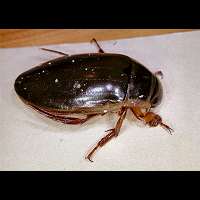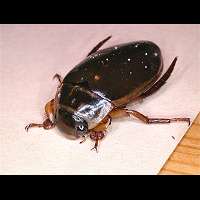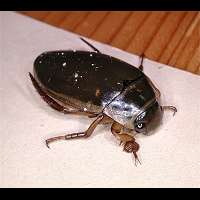[All pictures of garden wildlife on this page are thumbnails. Click on any thumbnail for a large format to be displayed.]

Water Tiger (Dytiscus marginalis)
| Taxonomy | ||||||
|---|---|---|---|---|---|---|
| Kingdom: | Phylum: | Class: | Order: | Family: | Genus: | Species: |
| Animalia | Arthropoda | Insecta | Coleoptera | Dytiscidae | Dytiscus | Dytiscus marginalis |
Even in small ponds you can find Diving Beetles. Some people wonder how they got there. Well, the Diving Beetles can do more than just dive: they can fly as well. So they can take many opportunities to explore new habitat with wells, ponds and streams. They are among the largest beetles in the Benelux area as they reach up to 4 centimeters in length! They swim using their rear legs. The front and middle legs are used to cling to plants in the water or to grab a prey. One of the best known water beetles in both Europe and America is the Water Tiger. The pictures are of a lonely male strolling through our garden on a windy and rainy March evening. You can distinguish the males from the females by the striking discs on the front legs of the males. These are sucking discs, which are used to get a hold of the fast swimming females during copulation.
The Water Tiger is an impressive large insect. The inividual in the pictures here was almost 38 mm! The adults live relatively long, sometimes they reach up to 5 years of age. In the moderate zones of Europe this is probably the longest living species of its kind. The larvae live solely in water and can reach up to 60 mm in length. Both adults and larvae are formidable hunters. Usually the larvae will attack any pray that is not much bigger than they are themselves. Adults do not pay attention to the size of the victim at all. It will attack any creature, even a fish well over one meter long, biting off a piece of flesh.Water Tigers can be very harmful to fish in a pond. Athough their bite will not kill a bigger fish immediately, but the bite wound gets often infected causing the victim to die eventually.
The adults are capable of biting people painfully. Larvae might bite people as well, but their jaws are rarely powerful enough to puncture the skin. Better don't experiment with them because if the larvae manages to penetrate your skin the bite is extremely painful. The larva injects its digestive acids immediately making the wound even more painful and causing it to heal extremely slowly.

© Copyright 1998-2024 gardensafari.net (Hania Berdys)

 English / engels
English / engels  Dutch / nederlands
Dutch / nederlands



